2017 Kia Niro
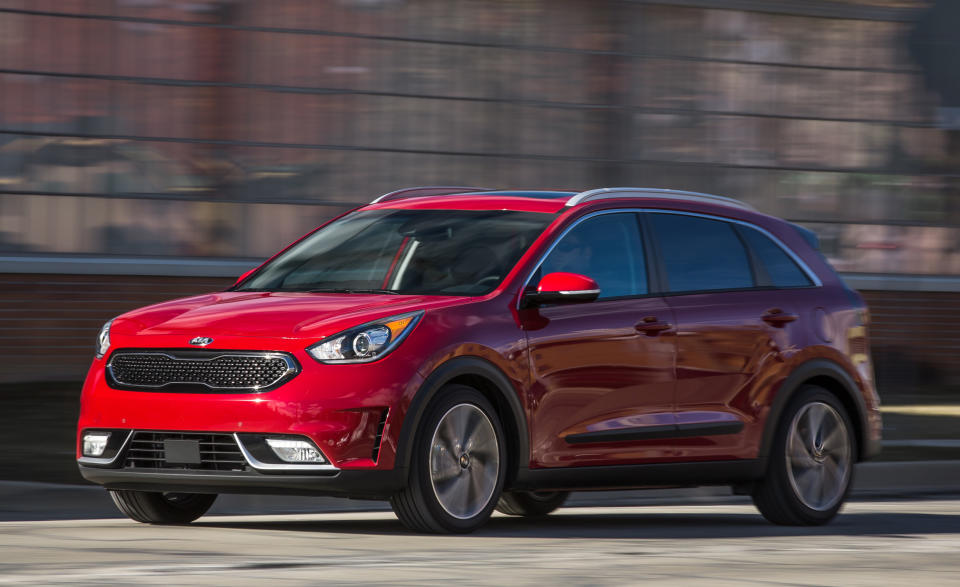
The iPod wasn’t the first MP3 player, millennials weren’t the first to point the camera back at the photographer, and the 2017 Kia Niro isn’t the first crossover to package a gas-electric hybrid powertrain under the hood. But just as Apple spurred digital music to ubiquity and the social-media generation wallpapered the internet with selfies, Kia’s Niro is the fully realized execution that could elevate the hybrid crossover to widespread adoption.
Twelve years after Ford added electric assist to its Escape (and five years after the automaker killed that offering), the small, hybridized utility vehicle finally lives up to its potential with the Niro. Rated at up to 50 mpg in the EPA’s combined measure, the Niro makes the lofty fuel-economy promises many buyers expect from hybrids. The starting price of $23,785 undercuts the prices of the 33-mpg Nissan Rogue and the 32-mpg Toyota RAV4 hybrids by several thousand dollars. It even slips under that of the green king, the Toyota Prius, by $575. And if driving a Prius makes the same fashion statement as donning a sweater vest over a turtleneck, the Niro wears like a pair of jeans and a Patagonia pullover—understated and trendy with a subtle air of eco credibility. We drove both the base Niro FE and the top-dog Touring to better understand why the different trims carry different EPA fuel-economy ratings.
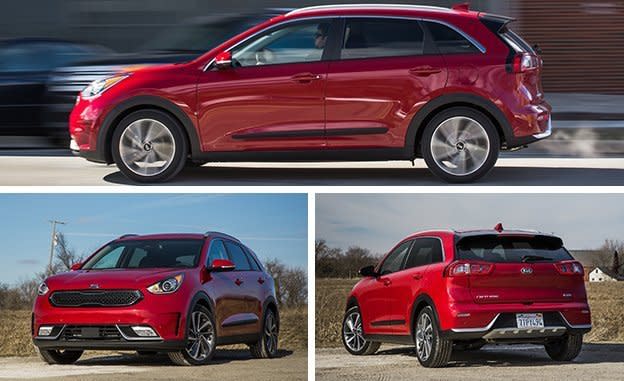
One Vehicle, Three Fuel-Economy Ratings
The Niro wears one of three different EPA labels depending on the trim level. The FE model (for Fuel Efficient) is the most frugal at 50 mpg combined, while the Niro Touring registers 43 mpg. The midrange LX and EX trims both carry a 49-mpg combined rating.
These differences are primarily the product of regulatory minutiae in the fuel-economy labeling game. While most cars have one fuel-economy label that lumps various trim levels into a single test that reflects the equipment level of the most popular variant, Kia parses the Niro into three separate certifications in order to get a bigger number for the lighter, lower-spec trims. Like we said: regulatory minutiae.
Our real-world findings suggest there is a distinction to be found in the fuel economy between the FE and Touring models, although it’s significantly smaller than the 7-mpg difference on the EPA labels. In our use, the Niro FE averaged 37 mpg, while the Touring model returned 35 mpg. Those figures climbed to 42 and 39 mpg, respectively, for the FE and the Touring on our 75-mph highway loop.

If 37 mpg seems like a far cry from the advertised 50 mpg, know that it’s still a remarkable figure for a crossover. You won’t find a more practical vehicle that returns better fuel economy, unless you’re willing to drive an electric car. For example, the Ford C-Max hybrid returned 32 mpg in our hands, while the all-wheel-drive Toyota RAV4 hybrid managed 31 mpg, and the Volkswagen Golf Sportwagen with front-wheel drive and an automatic transmission did 26 mpg.
Whether the $30,545 Touring is worth the 2-to-3-mpg fuel-economy hit is a matter of personal priorities. The FE has just enough luxuries to be considered well equipped, with satellite radio, dual-zone automatic climate control, and a 7.0-inch touchscreen with Android Auto and Apple CarPlay compatibility. We spotted only one overt sign of cheapness, and it’s hidden in the cargo area. In the FE, Kia withholds the cargo cover and instead provides a flimsy, ill-fitting panel where the carpeted floor mat would be in the Touring. Of course, the Touring also adds other features such as heated and ventilated front seats, leather upholstery, push-button starting, and a sunroof, but both cars boast comfortable cockpits with stylish materials, intuitive controls, and impressive quality.
The Anti-Prius
Kia’s hybrid powertrain is a relatively simple thing with a single electric motor/generator attached to the input shaft of the six-speed dual-clutch automatic gearbox. There’s also a clutch between the 1.6-liter inline-four engine and the 43-hp motor, which in theory permits electric-only driving, but in our experience the Niro made only momentary overtures at electric-only propulsion, primarily using its 43-hp motor to assist the 1.6-liter four-cylinder. One key advantage of this system is that it behaves similarly to a conventional gasoline-only vehicle, with a predictable correlation between vehicle speed and the engine’s efforts. You won’t find the labored moaning characteristic of Toyota’s complex two-motor, planetary-gear Hybrid Synergy Drive here.
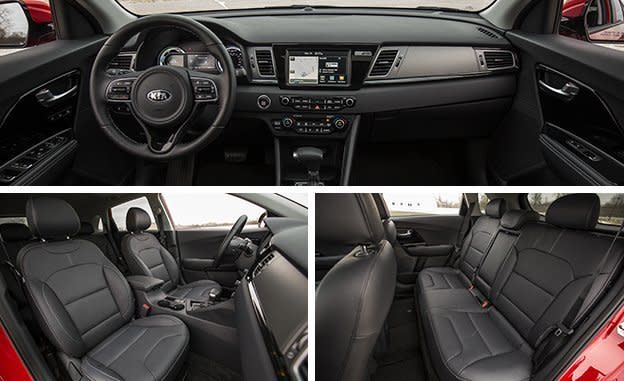
In our multiple encounters with various Niro test vehicles, though, we have repeatedly noticed some low-speed surges and pulses coming from the powertrain, presumably as the powertrain controller struggles to seamlessly blend engine and motor torque. These quiet hiccups are never abrupt nor harsh, and some drivers may not register them at all, as they are no more intrusive than an automatic transmission shifting through its gears. Still, they’re perceptible enough to warrant further development work on Kia’s end, and shoppers should look for this behavior on a test drive to determine if it will irk them over the long run.
Otherwise, the Niro largely drives as you’d expect a hybrid to drive, trading responsiveness for efficiency. The transmission’s default Eco mode undermines the low-end tug of the electric motor by racing to upshift through the gears. It’s possible to drive around this behavior by pushing deeper into the accelerator or by sliding the gear selector into Sport mode, but we’d prefer the standard mode were better matched to stop-and-go driving conditions.
The meager total power—just 139 horsepower—leaves the hybrid flat-footed when you stand on the accelerator. The Niro FE ambled to 60 mph in 8.9 seconds, while the heavier Touring stretched that time to a painfully slow 9.6 seconds. That 0.7-second margin is greater than the weight difference between the two trims would suggest, but it corroborates our observations that the FE feels more spritely in traffic. Our only explanation for the gulf between zero-to-60 times is that much of the Touring’s added heft is in its larger 18-inch wheels, so the powertrain has to accelerate that mass both rotationally and longitudinally as it moves the vehicle down the road.
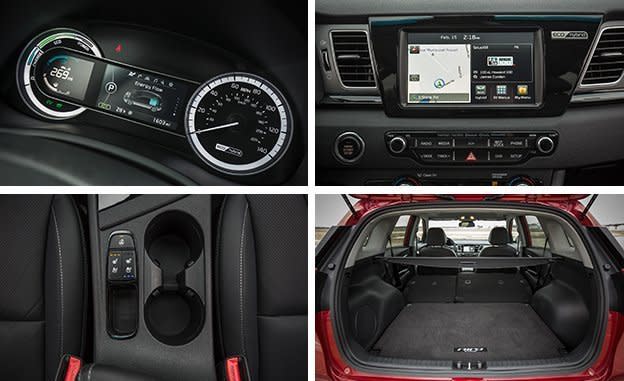
Both models deliver pleasant ride quality, sopping up mundane pavement patches, cracks, and heaves more gracefully than many other Kia vehicles. The Niro’s steering and handling largely mimic that of a car with nicely controlled body roll. While the FE’s lateral grip of 0.82 g is impressive, the Touring’s figure of 0.90 g is phenomenal for a hybrid without a Porsche badge on the hood. The Touring gains that advantage with tires that are grippier than the FE’s narrower, low-rolling-resistance Michelin Energy Saver A/S rubber.
Define “Crossover”
The Niro’s remarkable fuel economy and carlike handling aren’t anomalous, though. They’re made possible by the fact that Kia takes full advantage of the ambiguity in the word crossover. The Niro qualifies as a crossover only in the most superficial interpretation: a two-box wagon shape with a ribbon of black plastic ringing the body’s bottom edge and (on upper trims) a pair of roof-rack rails. All-wheel drive is not available, and ground clearance is comparable to that of most cars.
If it’s a high vantage point you seek, know that the Niro’s seat height is located in the gray area between cars and crossovers. At 23.1 inches, the Niro’s H-point falls between that of the typical car (around 19 to 20 inches) and conventional crossovers (in the 27- to 28-inch range). To our butts, the Niro feels just high enough to make entering and exiting the vehicle easy but not so high as to feel clumsy and stilted in corners. Those coming out of something taller, like a Honda CR-V (with a 5.0-inch-greater seat height) or a Toyota RAV4 (4.0 inches higher), might think otherwise.
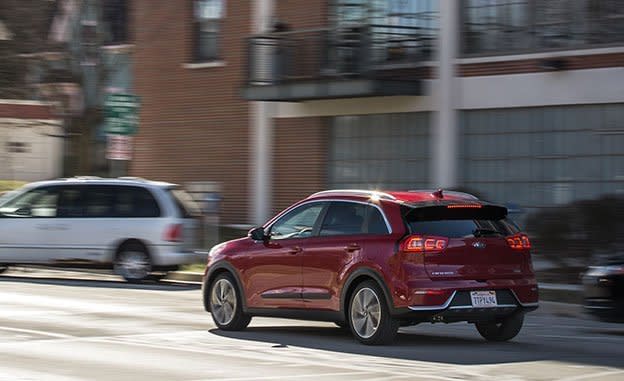
The Niro also measures roughly 10 inches shorter than those small-crossover standard-bearers, a critical factor in the Niro FE’s featherweight 3108-pound mass and thus its big fuel-economy numbers. Despite the truncated body, there’s still livable rear head- and legroom for adults in the back. You will sacrifice cargo space, though. Six carry-on-sized suitcases fit behind the rear seat, while a Honda CR-V will carry 10.
Style and Substance
The Kia Niro is the rare gas-electric vehicle to offer an emotional justification to the rational reasons for buying a hybrid. Beyond hitting a sweet spot of affordability, efficiency, and utility, the Niro adds handsome and fashionable style. By combining Kia’s sharp design language on top of the popular crossover form factor, the Niro is a Toyota Prius that we wouldn’t be embarrassed to own.
Specifications >
VEHICLE TYPE: front-engine, front-motor, front-wheel-drive, 5-passenger, 4-door hatchback
PRICE AS TESTED (FE/Touring):$23,785/$32,445 (base price: $23,785/$30,545)
ENGINE TYPE: DOHC 16-valve Atkinson-cycle 1.6-liter inline-4, 104 hp, 109 lb-ft; permanent-magnet synchronous AC motor, 43 hp, 125 lb-ft; combined output, 139 hp, 195 lb-ft; 1.6-kWh lithium-ion battery pack
TRANSMISSION: 6-speed dual-clutch automatic with manual shifting mode
DIMENSIONS:
Wheelbase: 106.3 in
Length: 171.5 in
Width: 71.1 in Height: 60.4 in
Passenger volume: 100 cu ft
Cargo volume: 19 cu ft
Curb weight: 3108/3264 lb (FE/Touring)
C/D TEST RESULTS (FE/Touring):
Zero to 60 mph: 8.6/9.6 sec
Zero to 100 mph: 26.7/30.9 sec
Rolling start, 5–60 mph: 8.9/9.8 sec
Top gear, 30–50 mph: 4.8/5.2 sec
Top gear, 50–70 mph: 6.5/6.9 sec
Standing ¼-mile: 16.7 sec @ 83 mph / 17.3 sec @ 80 mph
Top speed (drag/governor limited): 111/108 mph
Braking, 70–0 mph: 187/176 ft
Roadholding, 300-ft-dia skidpad: 0.82/0.90 g
FUEL ECONOMY (FE; Touring):
EPA combined/city/highway driving: 50/52/49 mpg; 43/46/40 mpg
C/D observed: 37 mpg; 35 mpg
C/D observed 75-mph highway driving: 42 mpg; 39 mpg
C/D observed highway range: 490 mi; 460 mi

 Yahoo Autos
Yahoo Autos 